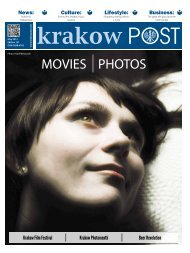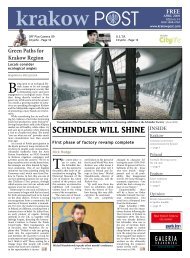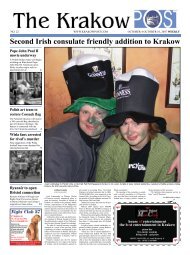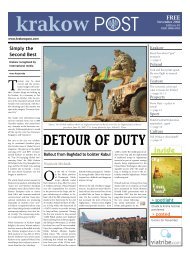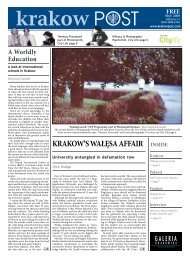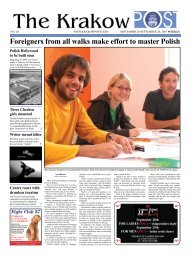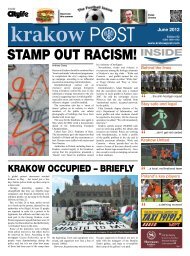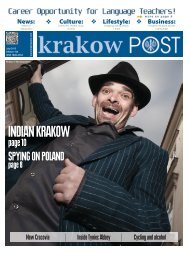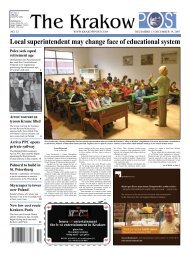November of memory: Poland remembers those who ... - Krakow Post
November of memory: Poland remembers those who ... - Krakow Post
November of memory: Poland remembers those who ... - Krakow Post
Create successful ePaper yourself
Turn your PDF publications into a flip-book with our unique Google optimized e-Paper software.
10 The <strong>Krakow</strong> <strong>Post</strong><br />
K R A K O W<br />
NOVEMBER 1-NOVEMBER 7, 2007<br />
“Indian Puzzles” pieces together colorful image <strong>of</strong> India<br />
Adelina Krupski<br />
Photography.<br />
Though having previously exhibited<br />
other works in Warsaw and the Photography<br />
Festival in Lodz, this is her first individual,<br />
public exhibit.<br />
The main space <strong>of</strong> the Pauza Club, facing<br />
ul. Florianska, holds some <strong>of</strong> the works, displayed<br />
in a large format. In addition, a separate<br />
room contains the <strong>who</strong>le twenty-piece<br />
collection lined up, with some <strong>of</strong> the main<br />
works repeated in a smaller version.<br />
Unfortunately, not all <strong>of</strong> the photographs<br />
Rzymanek would have liked to share are included<br />
in the exhibit. In fact, it could be said<br />
that there are missing pieces to the puzzle.<br />
Nevertheless, the selection successfully reflects<br />
the vision and approach <strong>of</strong> the artist,<br />
through astonishing, vivid scenes, conveying<br />
a blend <strong>of</strong> visual, sensory and spiritual<br />
elements.<br />
For more information, contact or visit:<br />
Pauza<br />
ul. Florianska 18/3 – 1st floor<br />
pauza@pauza.pl<br />
www.pauza.pl<br />
Magdalena Rzymanek, holding the Holga camera, with which she traveled to India and photographed the scenes comprising “Indian Puzzles.”<br />
Adelina Krupski<br />
Staff Journalist<br />
The exhibit titled “Indian Puzzles,” made<br />
up <strong>of</strong> a series <strong>of</strong> color photographs taken by<br />
Magdalena Rzymanek during her travels<br />
throughout India last year, is currently on<br />
display at the Pauza Club in <strong>Krakow</strong>, continuing<br />
until Nov. 30.<br />
Rzymanek, a photographer originating<br />
from the Silesia region in <strong>Poland</strong>, traveled to<br />
India in December 2006 with the aim <strong>of</strong> photographing<br />
the country in a way that would<br />
capture its overwhelming sense <strong>of</strong> variety,<br />
uncertainty, and contrast. She accomplished<br />
this, using a Holga, a cheaply manufactured,<br />
medium-format, 120-film toy camera that<br />
<strong>of</strong>ten causes distorting effects, such as light<br />
leaks and blur.<br />
As a result, the photographs come across<br />
as obscure and dreamlike, while also communicating<br />
liveliness through wonderfully<br />
vibrant colors. These effects, states Rzymanek,<br />
“are part <strong>of</strong> the camera’s charm.”<br />
While the photographer does, for the most<br />
part, retain control over the camera, another<br />
exciting peculiarity <strong>of</strong> the Holga is the way<br />
in which the final outcome remains unpredictable.<br />
Developed commercially and transferred<br />
onto computer solely for printing purposes,<br />
the photographs are presented in their natural<br />
state, free <strong>of</strong> any further manipulation.<br />
Rzymanek says that, on her first trip to India<br />
three years ago, she used a digital camera<br />
and found it did not suit the project, as it<br />
failed to meet the desired effect and the photographs<br />
did not have the right impact.<br />
The pieces comprising the collection<br />
are unique, not only for their angle, diversity<br />
and style, but also for the technique by<br />
which they are created. “When taking these<br />
photographs,” says Rzymanek, “I was led<br />
by my emotions.” Consequently, the photographs<br />
depict a variety <strong>of</strong> subject matters,<br />
such as people, places, architecture, and<br />
animals, encountered in the different areas<br />
<strong>of</strong> Rzymanek visited, namely the cities <strong>of</strong><br />
Delhi, Agra, Goa, Jodhpur, Varanasi, Hyderabad<br />
and Mysore.<br />
According to Rzymanek, “nothing is for<br />
certain in India, either visually or even in the<br />
mentality <strong>of</strong> the people – everything is there,<br />
tangled together.” She mentions the example<br />
<strong>of</strong> the gap between wealth and poverty.<br />
“The Taj Mahal, for instance, enormous and<br />
magical, makes an unbelievable impression,<br />
though just outside <strong>those</strong> walls, it’s filled<br />
with poverty – India is a very contrasting<br />
country.”<br />
Originally having studied biology, Rzymanek<br />
started pursuing photography during<br />
her second year in college, a passion which<br />
led her to enroll in the Warsaw School <strong>of</strong><br />
Photos at the exhibit.<br />
“Raz, Dwa, Trzy”<br />
krakowpost.com<br />
Krzyszt<strong>of</strong> Skonieczn<br />
Staff Journalist<br />
This week will be a busy one for the Rotunda Community<br />
Center, which will be hosting two musical performances<br />
by two major Polish bands.<br />
On Sunday, Nov. 4, the club will host the band, Kult.<br />
Wednesday, Nov. 7 will feature a musical performance by<br />
Raz, Dwa, Trzy.<br />
Regardless <strong>of</strong> the important role Polish lyrics may<br />
play in their songs, both <strong>of</strong> the groups are, music-wise,<br />
recommendable even for <strong>those</strong> <strong>who</strong> are not fluent in the<br />
language.<br />
When, in 1982, vocalist Kazik Staszewski and his<br />
companions changed the name <strong>of</strong> their band, ‘Novelty<br />
<strong>Poland</strong>’ to ‘Kult’, they must have done it with a kind <strong>of</strong><br />
prophetic vision.<br />
For the past 25 years, the group has become one <strong>of</strong><br />
<strong>Poland</strong>’s “cult bands.”<br />
Deriving from punk rock, the group mixes it’s sounds<br />
with new wave, rock, jazz and traditional Polish balladsall<br />
paired with Staszewski’s charismatic voice and somewhat<br />
controversial personality.<br />
One <strong>of</strong> the most notorious details about the band is<br />
the unique atmosphere they create during their long and<br />
intense performances: a sense <strong>of</strong> youthful rebelliousness<br />
that doesn’t seem to grow old, despite the age <strong>of</strong> the musicians.<br />
Almost ten years junior <strong>of</strong> ‘Kult’, ‘Raz, Dwa, Trzy’<br />
seems to present a paradoxically higher level <strong>of</strong> maturity<br />
– if measured by the level <strong>of</strong> composure.<br />
Their musical style oscillates between rock and smooth<br />
jazz, and the lyrics have the form <strong>of</strong> contemporary poetry,<br />
to which the s<strong>of</strong>t, pleasing voice <strong>of</strong> front man Adam<br />
Nowak fits perfectly.<br />
Their interesting and witty songs address subjects <strong>of</strong><br />
love and religion. Recently, the band has become increasingly<br />
interested in presenting their own versions <strong>of</strong> songs<br />
written by famous Polish poets.<br />
In 2002 they recorded an album filled with songs <strong>of</strong><br />
Agnieszka Osiecka, for the fifth anniversary <strong>of</strong> the poet’s<br />
death. Their latest album is called “Młynarski,” the name<br />
<strong>of</strong> the poet <strong>who</strong>se songs they are covering.<br />
Even though the pieces are not the group’s original<br />
creations, their renditions <strong>of</strong>fers a fresh look, which is<br />
certainly worth listening to.



